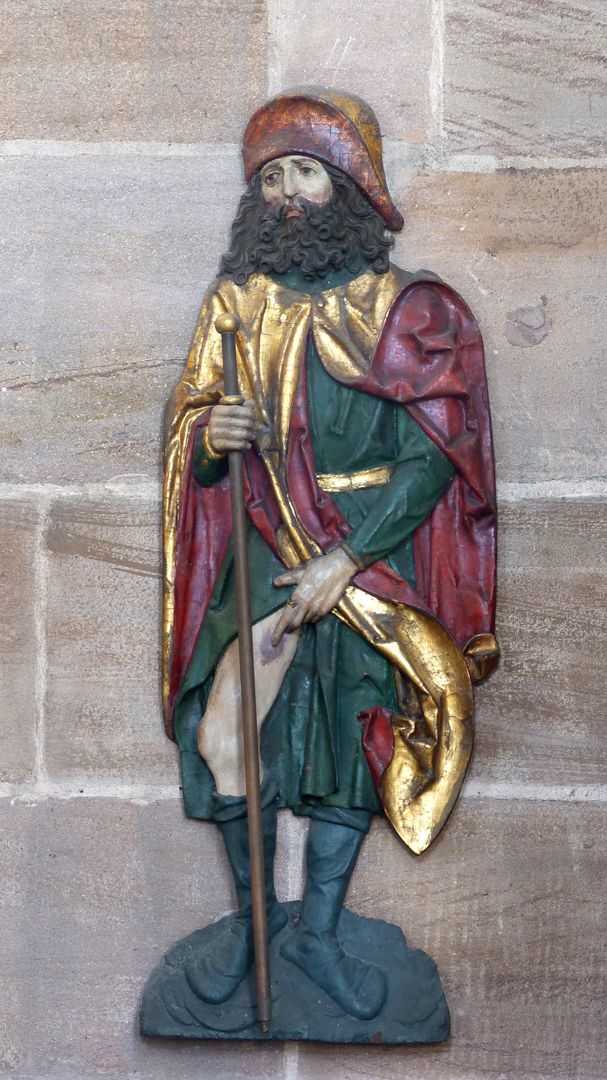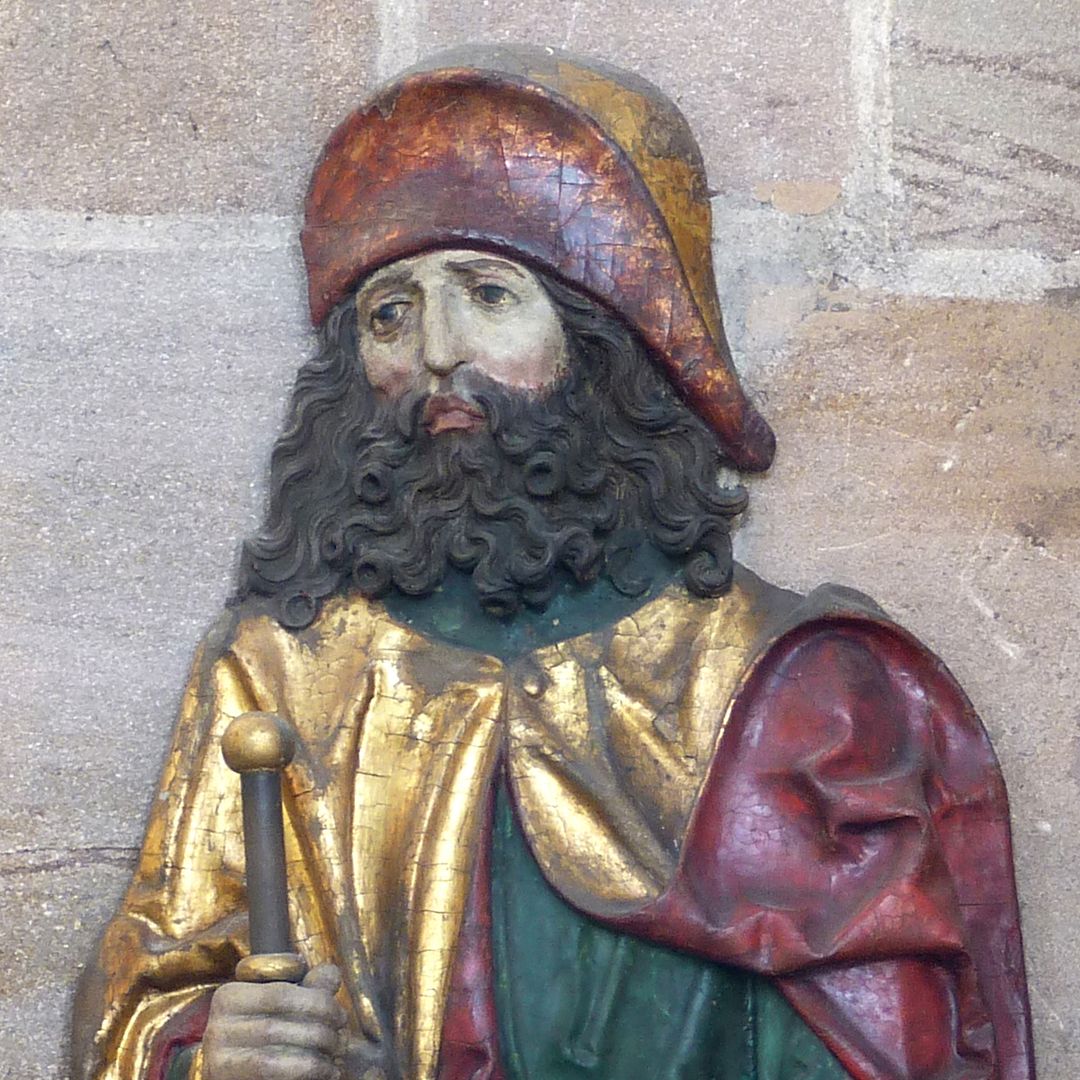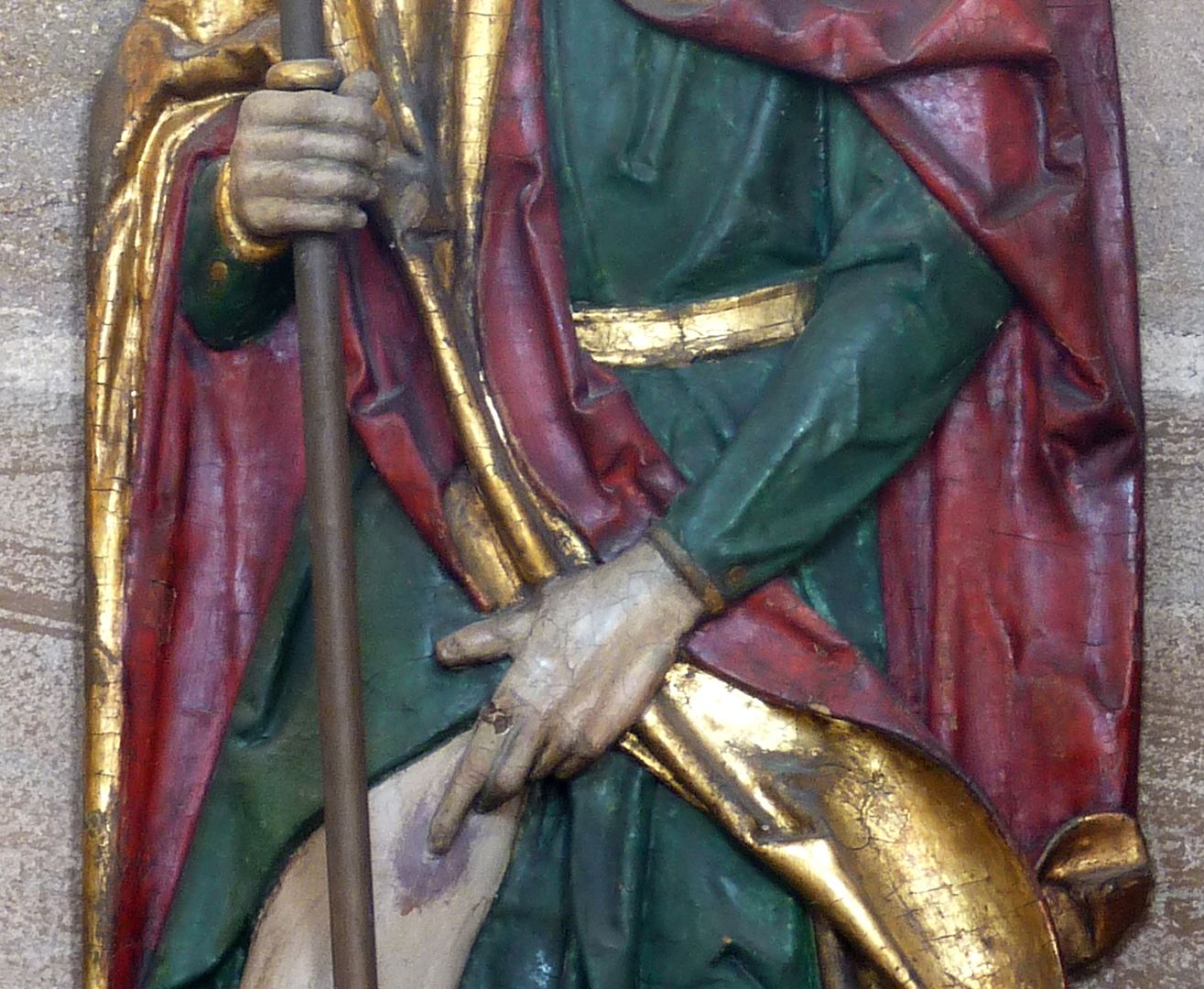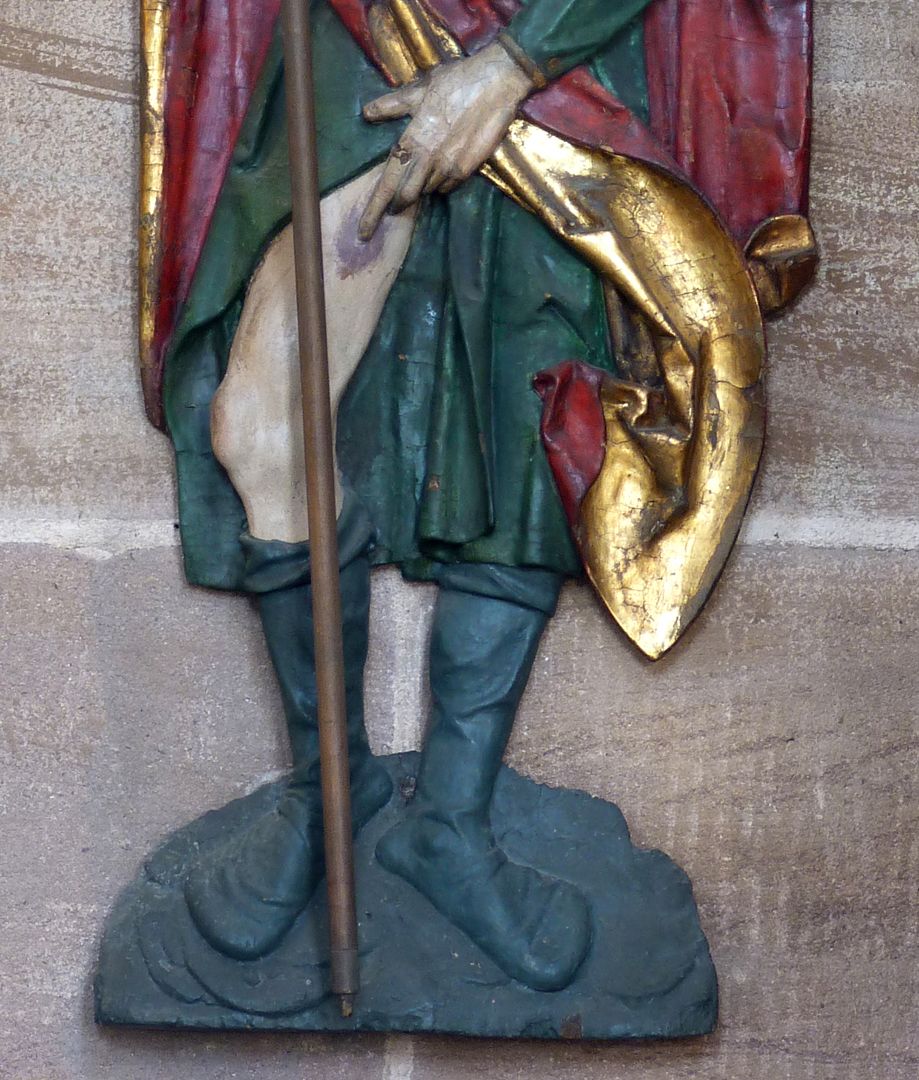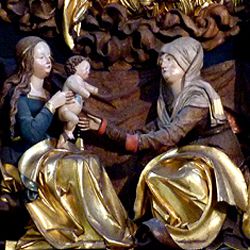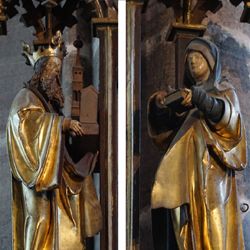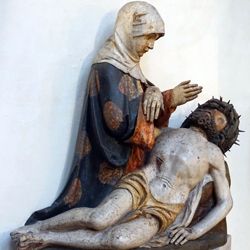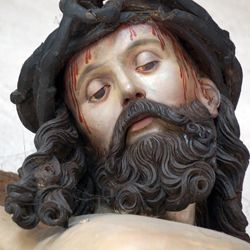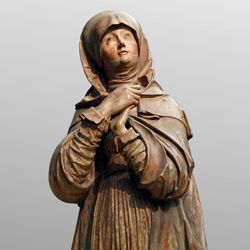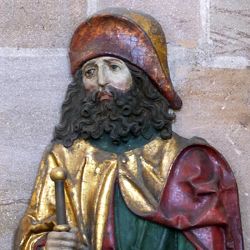Rochus
Rochus
around 1515
Master Jörg and workshop. Bas-relief, formerly from a right wing of an unknown altar.
"The full-bearded face of St. Roch, fringed with long wavy hair, clearly shows the close relationship with the Bruck predella apostles and the wing reliefs. Undoubtedly, the same carver was at work here, whose formal language, which seems quite conventional compared to the shrine and sprinkler figures, betrays an influence by Main Franconian models of the Riemenschneider circle." (Stefan Roller, Hans von Kulmbach und der Nürnberger Bildschnitzer Meister Jörg, in: Renaissance in Franken. Hans von Kulmbach and the Art around Dürer, 2022, p. 109).
"Certainly a St. Sebastian stood opposite the relief as a counterpart on the left wing [of a now lost altar]. It would therefore be worth considering whether the relief might not have been part of the southern side altar dedicated to Mary and the Helpers of Help in the demolished Sebastian chapel of the hospital of the same name in Nuremberg, with which Gerhard Weilandt associated the two altar paintings in the Albertina in Vienna, dated 1508 and 1511". (Roller, p. 124, note 30)
The Sebastian Chapel, built in 1509/13 according to plans by Hans Beheim (formerly on the property at Großweidenmühlstraße 31-35), was demolished along with the hospital complex during the Second Margravial War in 1552, and the chapel was dispensed with during reconstruction.
Location: Nuremberg, Rochus Chapel in the Rochus Cemetery
Design: Herb (Meister Jörg Pildschnitzer), Georg
Realization: Herb (Meister Jörg Pildschnitzer), Georg
Material: Wood
photo 2012, Pablo de la Riestra
Rochus
around 1515
Detail view
Master Jörg and workshop. Bas-relief, formerly from a right wing of an unknown altar.
"The full-bearded face of St. Roch, fringed with long wavy hair, clearly shows the close relationship with the Bruck predella apostles and the wing reliefs. Undoubtedly, the same carver was at work here, whose formal language, which seems quite conventional compared to the shrine and sprinkler figures, betrays an influence by Main Franconian models of the Riemenschneider circle." (Stefan Roller, Hans von Kulmbach und der Nürnberger Bildschnitzer Meister Jörg, in: Renaissance in Franken. Hans von Kulmbach and the Art around Dürer, 2022, p. 109).
"Certainly a St. Sebastian stood opposite the relief as a counterpart on the left wing [of a now lost altar]. It would therefore be worth considering whether the relief might not have been part of the southern side altar dedicated to Mary and the Helpers of Help in the demolished Sebastian chapel of the hospital of the same name in Nuremberg, with which Gerhard Weilandt associated the two altar paintings in the Albertina in Vienna, dated 1508 and 1511". (Roller, p. 124, note 30)
The Sebastian Chapel, built in 1509/13 according to plans by Hans Beheim (formerly on the property at Großweidenmühlstraße 31-35), was demolished along with the hospital complex during the Second Margravial War in 1552, and the chapel was dispensed with during reconstruction.
Location: Nuremberg, Rochus Chapel in the Rochus Cemetery
Design: Herb (Meister Jörg Pildschnitzer), Georg
Realization: Herb (Meister Jörg Pildschnitzer), Georg
Material: Wood
photo 2012, Pablo de la Riestra
Rochus
around 1515
Detail view
Master Jörg and workshop. Bas-relief, formerly from a right wing of an unknown altar.
"The full-bearded face of St. Roch, fringed with long wavy hair, clearly shows the close relationship with the Bruck predella apostles and the wing reliefs. Undoubtedly, the same carver was at work here, whose formal language, which seems quite conventional compared to the shrine and sprinkler figures, betrays an influence by Main Franconian models of the Riemenschneider circle." (Stefan Roller, Hans von Kulmbach und der Nürnberger Bildschnitzer Meister Jörg, in: Renaissance in Franken. Hans von Kulmbach and the Art around Dürer, 2022, p. 109).
"Certainly a St. Sebastian stood opposite the relief as a counterpart on the left wing [of a now lost altar]. It would therefore be worth considering whether the relief might not have been part of the southern side altar dedicated to Mary and the Helpers of Help in the demolished Sebastian chapel of the hospital of the same name in Nuremberg, with which Gerhard Weilandt associated the two altar paintings in the Albertina in Vienna, dated 1508 and 1511". (Roller, p. 124, note 30)
The Sebastian Chapel, built in 1509/13 according to plans by Hans Beheim (formerly on the property at Großweidenmühlstraße 31-35), was demolished along with the hospital complex during the Second Margravial War in 1552, and the chapel was dispensed with during reconstruction.
Location: Nuremberg, Rochus Chapel in the Rochus Cemetery
Design: Herb (Meister Jörg Pildschnitzer), Georg
Realization: Herb (Meister Jörg Pildschnitzer), Georg
Material: Wood
photo 2012, Pablo de la Riestra
Rochus
around 1515
Detail view
Master Jörg and workshop. Bas-relief, formerly from a right wing of an unknown altar.
"The full-bearded face of St. Roch, fringed with long wavy hair, clearly shows the close relationship with the Bruck predella apostles and the wing reliefs. Undoubtedly, the same carver was at work here, whose formal language, which seems quite conventional compared to the shrine and sprinkler figures, betrays an influence by Main Franconian models of the Riemenschneider circle." (Stefan Roller, Hans von Kulmbach und der Nürnberger Bildschnitzer Meister Jörg, in: Renaissance in Franken. Hans von Kulmbach and the Art around Dürer, 2022, p. 109).
"Certainly a St. Sebastian stood opposite the relief as a counterpart on the left wing [of a now lost altar]. It would therefore be worth considering whether the relief might not have been part of the southern side altar dedicated to Mary and the Helpers of Help in the demolished Sebastian chapel of the hospital of the same name in Nuremberg, with which Gerhard Weilandt associated the two altar paintings in the Albertina in Vienna, dated 1508 and 1511". (Roller, p. 124, note 30)
The Sebastian Chapel, built in 1509/13 according to plans by Hans Beheim (formerly on the property at Großweidenmühlstraße 31-35), was demolished along with the hospital complex during the Second Margravial War in 1552, and the chapel was dispensed with during reconstruction.
Location: Nuremberg, Rochus Chapel in the Rochus Cemetery
Design: Herb (Meister Jörg Pildschnitzer), Georg
Realization: Herb (Meister Jörg Pildschnitzer), Georg
Material: Wood
photo 2021, Pablo de la Riestra
